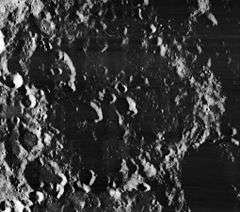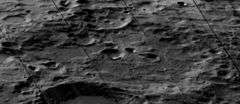Tsander (crater)
Tsander is a large lunar impact crater on the far side of the Moon. Attached to the southeastern outer rim is the younger crater Kibal'chich. To the northwest lies Dirichlet, and to the northeast lies Artem'ev.
.png) LRO image (Tsander is heavily eroded large crater in the center) | |
| Coordinates | 5.39°N 149.69°W |
|---|---|
| Diameter | 181 km |
| Depth | Unknown |
| Colongitude | 151° at sunrise |
| Eponym | Friedrich Zander |


This is a heavily worn crater formation with an outer rim that has been rendered into an uneven, somewhat circular range due to impact erosion. There is a significant outward bulge along the rim edge to the south-southwest. A smaller crater lies across the rim to the west-northwest. The interior floor has low ridges and uneven areas most likely as the result of large deposits of ejecta. There is a cluster of small craters near the midpoint of the interior, and the worn remains of a pair of older impacts in the north and west.
Tsander lies to the southeast of the Dirichlet-Jackson Basin.
This crater takes its name from the Cyrillic rendering of Friedrich Zander, an early developer of rocket engines.
Satellite craters
By convention these features are identified on lunar maps by placing the letter on the side of the crater midpoint that is closest to Tsander.
| Tsander | Coordinates | Diameter, km |
|---|---|---|
| B | 9.01°N 147.68°W | 55 |
| R | 3.05°N 152.81°W | 34 |
| S | 5.35°N 150.04°W | 18 |
| V | 7.46°N 154.08°W | 35 |
References
- Andersson, L. E.; Whitaker, E. A. (1982). NASA Catalogue of Lunar Nomenclature. NASA RP-1097.CS1 maint: ref=harv (link)
- Blue, Jennifer (July 25, 2007). "Gazetteer of Planetary Nomenclature". USGS. Retrieved 2014-12-06.CS1 maint: ref=harv (link)
- Bussey, B.; Spudis, P. (2004). The Clementine Atlas of the Moon. New York: Cambridge University Press. ISBN 978-0-521-81528-4.CS1 maint: ref=harv (link)
- Cocks, Elijah E.; Cocks, Josiah C. (1995). Who's Who on the Moon: A Biographical Dictionary of Lunar Nomenclature. Tudor Publishers. ISBN 978-0-936389-27-1.CS1 maint: ref=harv (link)
- McDowell, Jonathan (July 15, 2007). "Lunar Nomenclature". Jonathan's Space Report. Retrieved 2007-10-24.CS1 maint: ref=harv (link)
- Menzel, D. H.; Minnaert, M.; Levin, B.; Dollfus, A.; Bell, B. (1971). "Report on Lunar Nomenclature by the Working Group of Commission 17 of the IAU". Space Science Reviews. 12 (2): 136–186. Bibcode:1971SSRv...12..136M. doi:10.1007/BF00171763.CS1 maint: ref=harv (link)
- Moore, Patrick (2001). On the Moon. Sterling Publishing Co. ISBN 978-0-304-35469-6.CS1 maint: ref=harv (link)
- Price, Fred W. (1988). The Moon Observer's Handbook. Cambridge University Press. ISBN 978-0-521-33500-3.CS1 maint: ref=harv (link)
- Rükl, Antonín (1990). Atlas of the Moon. Kalmbach Books. ISBN 978-0-913135-17-4.CS1 maint: ref=harv (link)
- Webb, Rev. T. W. (1962). Celestial Objects for Common Telescopes (6th revised ed.). Dover. ISBN 978-0-486-20917-3.CS1 maint: ref=harv (link)
- Whitaker, Ewen A. (2003). Mapping and Naming the Moon. Cambridge University Press. ISBN 978-0-521-54414-6.CS1 maint: ref=harv (link)
- Wlasuk, Peter T. (2000). Observing the Moon. Springer. ISBN 978-1-85233-193-1.CS1 maint: ref=harv (link)